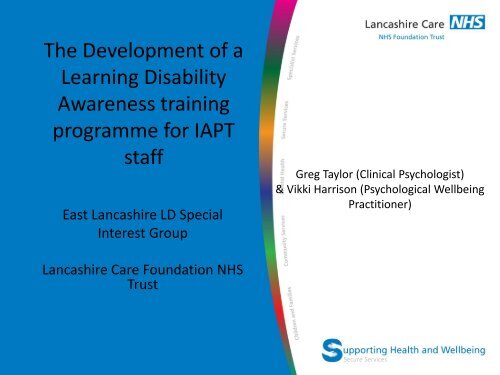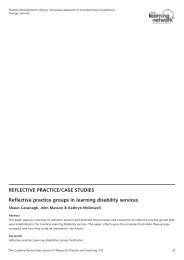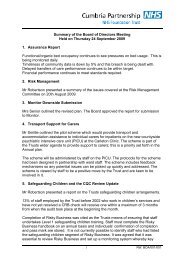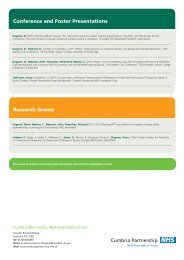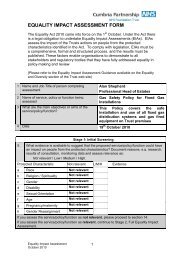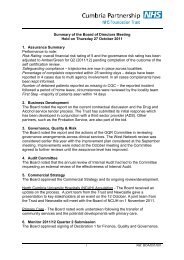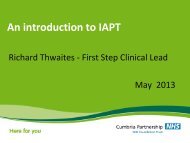LD IAPT training presentation Taylor and Harrison - Cumbria ...
LD IAPT training presentation Taylor and Harrison - Cumbria ...
LD IAPT training presentation Taylor and Harrison - Cumbria ...
You also want an ePaper? Increase the reach of your titles
YUMPU automatically turns print PDFs into web optimized ePapers that Google loves.
The Development of aLearning DisabilityAwareness <strong>training</strong>programme for <strong>IAPT</strong>staffEast Lancashire <strong>LD</strong> SpecialInterest GroupGreg <strong>Taylor</strong> (Clinical Psychologist)& Vikki <strong>Harrison</strong> (Psychological WellbeingPractitioner)Lancashire Care Foundation NHSTrustSecure ServicesSecure Services
The Development of a LearningDisability Awareness <strong>training</strong>programme for <strong>IAPT</strong> staffOverview1) Service context2) <strong>IAPT</strong> <strong>LD</strong> Special Interest Group3) Background to <strong>training</strong>4) Training day overview5) Outcomes from <strong>training</strong>6) Future DirectionsSecure Services
Introduction & BackgroundService Context• 5 Distinct Primary Care <strong>IAPT</strong> services– Differing demographics etc• Largely economically deprived, high levels of unemployment but alsomore affluent areas• Urban, rural <strong>and</strong> semi-rural• <strong>IAPT</strong> provision of step 2 (PWP) & Step 3 (counselling, OccupationalTherapy, HIT (CBT) workers, Clinical Psychology <strong>and</strong> MHP’s)Secure Services
Introduction & Background<strong>LD</strong> Special Interest Group Context• <strong>IAPT</strong> special interest group• Remit to identify <strong>and</strong> address access <strong>and</strong> governance issues in relation to<strong>LD</strong> population• Collaboration between <strong>IAPT</strong> staff <strong>and</strong> Mental Health <strong>and</strong> LearningDisability Liaison Team• Quarterly meetings focusing on variety of issues around improving accessfor clients <strong>and</strong> adjusting aspects of service <strong>and</strong> it’s offering to achieve thisSecure Services
Introduction & BackgroundTraining day development• ‘Needs analysis’ survey of clinician confidence in working with <strong>LD</strong> clients –adapted from D. Dagnan’s confidence scale (thanks Dave!)• Suggested low levels of confidence <strong>and</strong> a perceived need for <strong>training</strong>around <strong>LD</strong> clients <strong>and</strong> their needs <strong>and</strong> around how to use resources <strong>and</strong>existing interventions• Slightly higher confidence in ‘generic’ clinical confidence but low acrossthe board• SIG agreement that results suggest need for awareness <strong>training</strong>Secure Services
The Training DayAim of the day• To raise awareness of how to work therapeutically with adults withlearning disabilities who are experiencing mental health problems.Learning Outcomes• Increase underst<strong>and</strong>ing about learning disabilities• Develop a range of communication skills• Improve accessibility to Steps 2 & 3 services to people with learningdisabilities through using ‘Reasonable Adjustments’• Consider how to adapt own practice i.e. assessment tools, therapeuticinterventions <strong>and</strong> resources in order to work with client with <strong>LD</strong>.Secure Services
The Training DaySchedule1. What is a Learning Disability?2. Values <strong>and</strong> beliefs3. Guest speakers-<strong>LD</strong> service users experiences4. Communicative methods <strong>and</strong> means with <strong>IAPT</strong> clients5. Reasonable adjustmentsSecure Services
Training outcomesPre- <strong>and</strong> post- scores across 2 <strong>training</strong> days by <strong>IAPT</strong> role(N 29) Professional Role Pre MeanTotal ScorePre SD Post Mean Post SD14 PWP 24.36 10.78 38.29 9.506 Counsellor 26.83 9.11 35.50 6.694 CBT Therapist 23.25 8.85 28.00 6.381 HIT Therapist 30.00 - 42.00 -3 OT 31.50 2.12 48.00 1.412 MHP 41.50 19.10 47.50 9.19• Individual item means(1=low, 5=high): Pre (n=26) 2.88 – Post (n=35) – 3.715• Wilcoxon matched-pairs analysis (n=29) shows significant increase in post-<strong>training</strong>confidence scores (p
Training outcomesOther outcomes• Increased awareness of <strong>LD</strong> SIG, role <strong>and</strong> membership• ‘Top Tips’ leaflets – drawn from attendee contributions to reasonableadjustment ‘workshop’ – versions for therapists <strong>and</strong> ELSPoA triage staff• Confidence in <strong>training</strong> model to continue to provide 1-day <strong>training</strong> yearlySecure Services
Future DirectionsLearning Disabilities WebpageDesigned for staff, those with learning disabilities <strong>and</strong>families/carers. Primary aim of sharing resources from <strong>training</strong>Also…Continue to provide awareness <strong>training</strong>(<strong>and</strong> to have this recognised asm<strong>and</strong>atory)Considering ‘modality specific’ <strong>training</strong>Possible MSc research into clinicianattitudes towards working withpopulationSecure ServicesStill perception that actual referrals into<strong>IAPT</strong> are lower than expected – need toinvestigate <strong>and</strong> create better links withC<strong>LD</strong>T’s
Secure Services


